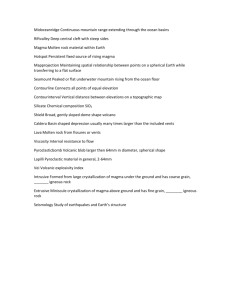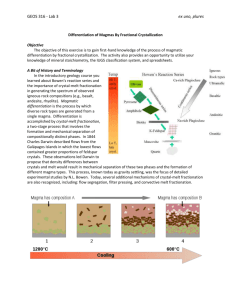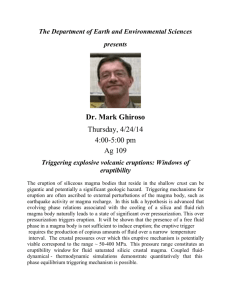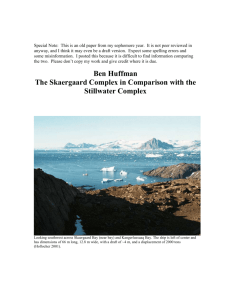The Skaergaard Intrusion
advertisement
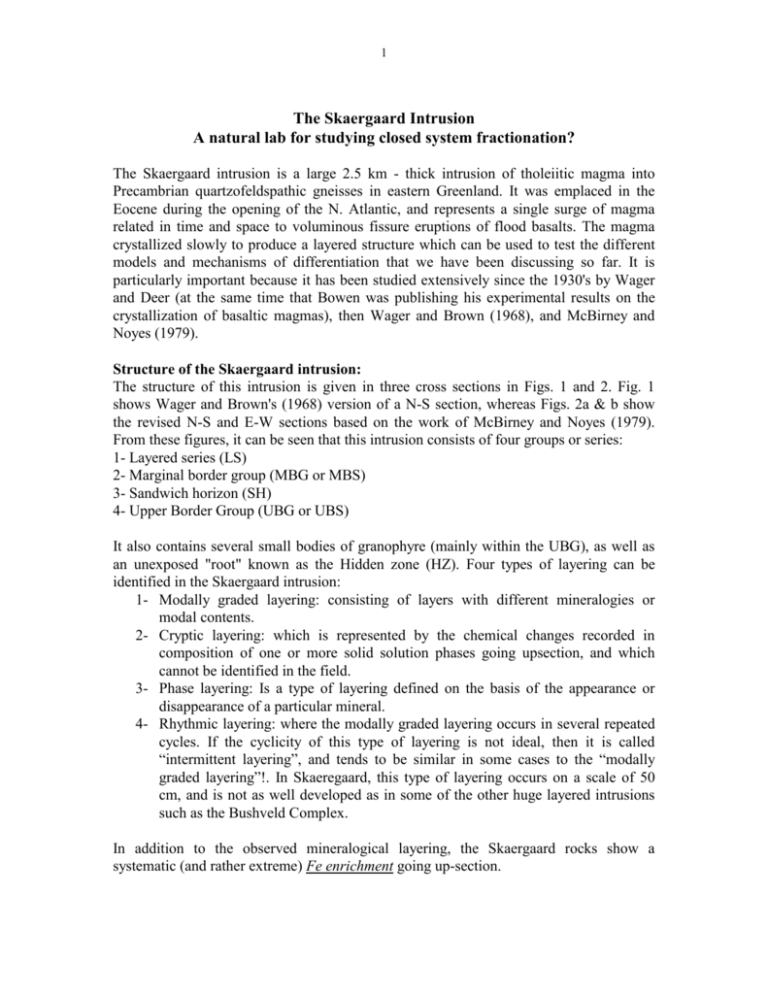
1 The Skaergaard Intrusion A natural lab for studying closed system fractionation? The Skaergaard intrusion is a large 2.5 km - thick intrusion of tholeiitic magma into Precambrian quartzofeldspathic gneisses in eastern Greenland. It was emplaced in the Eocene during the opening of the N. Atlantic, and represents a single surge of magma related in time and space to voluminous fissure eruptions of flood basalts. The magma crystallized slowly to produce a layered structure which can be used to test the different models and mechanisms of differentiation that we have been discussing so far. It is particularly important because it has been studied extensively since the 1930's by Wager and Deer (at the same time that Bowen was publishing his experimental results on the crystallization of basaltic magmas), then Wager and Brown (1968), and McBirney and Noyes (1979). Structure of the Skaergaard intrusion: The structure of this intrusion is given in three cross sections in Figs. 1 and 2. Fig. 1 shows Wager and Brown's (1968) version of a N-S section, whereas Figs. 2a & b show the revised N-S and E-W sections based on the work of McBirney and Noyes (1979). From these figures, it can be seen that this intrusion consists of four groups or series: 1- Layered series (LS) 2- Marginal border group (MBG or MBS) 3- Sandwich horizon (SH) 4- Upper Border Group (UBG or UBS) It also contains several small bodies of granophyre (mainly within the UBG), as well as an unexposed "root" known as the Hidden zone (HZ). Four types of layering can be identified in the Skaergaard intrusion: 1- Modally graded layering: consisting of layers with different mineralogies or modal contents. 2- Cryptic layering: which is represented by the chemical changes recorded in composition of one or more solid solution phases going upsection, and which cannot be identified in the field. 3- Phase layering: Is a type of layering defined on the basis of the appearance or disappearance of a particular mineral. 4- Rhythmic layering: where the modally graded layering occurs in several repeated cycles. If the cyclicity of this type of layering is not ideal, then it is called “intermittent layering”, and tends to be similar in some cases to the “modally graded layering”!. In Skaeregaard, this type of layering occurs on a scale of 50 cm, and is not as well developed as in some of the other huge layered intrusions such as the Bushveld Complex. In addition to the observed mineralogical layering, the Skaergaard rocks show a systematic (and rather extreme) Fe enrichment going up-section. 2 I- The layered Series: Consists of cumulates which have their crystals oriented with their long axes parallel to what appears to be the base of the intrusion or magma chamber. From the bottom upwards, the LS consists of: (Figs. 3 & 4) (1) Lower zone a: Ol + Plag as cumulus phases, Cpx as an intercumulus phase (Fig. 5b) (2) Lower zone b: Cumulus Cpx + Ol + Plag (3) Lower zone c: Cumulus Mgt + Ol + Plag (Fig. 5c) (4) Middle zone: Ol disappears, its place is taken by pigeonite (Ca-poor Cpx) known as "inverted pigeonite" because it was originally an Opx (Fig. 5d; see also Fig. 6 for compositions of pyroxenes from the LZ to the UZ). (5) Upper zone a: Olivine reappears, but this time it is Fa - rich. (6) Upper zone b: Apatite appears, along with continued precipitation of Plag and Farich Ol (Fig. 5e). (7) Upper zone C: Hedenbergitic Cpx + Fa - rich Ol + intermediate Plag (andesine) (Fig. 5f; Fig. 6). Keep in mind that within the LS, Plag and Ol are becoming progressively richer in Ab and Fa, respectively (cryptic layering; Figs. 3 & 4). There are also many sedimentary like structures (e.g. graded bedding, cross- bedding, .. etc.) II- Sandwich Horizon: Massive intermediate to acidic rocks consisting of Oligoclase + ferrohedenbergite + fayalitic olivine + K-spar + Qz. The latter two minerals are intergrown to give a granophyric texture, and constitute ~ 5% of the mode. These rocks also contain accessory zircon, sphene and sulfides. III- The Upper Border Group: Rocks of the UBG are more enriched in Plag compared to the other series, and unlike the LS, their crystals seem to have grown in a direction perpendicular to the roof. Their cryptic layering also appears to be "upside down", with the Plag and Ol becoming more enriched in Ab and Fa away from the roof (Fig. 3). Granophyric textures between Qz and K-spar are more abundant in rocks of this group. In addition, small bodies of granophyre occur in this group either as pods or sills. IV- The Marginal Border Group: Consists of a chilled margin and fine-grained massive gabbros with many xenoliths of the country rock gneisses. This chilled margin is approximately 1 m in thickness, followed by 60 m of fine-grained massive gabbros, which are in turn followed by alternating layers of nearly monomineralic rocks consisting of wavy Cpx and plagioclase, which are all oriented perpendicular to the margins of this intrusion. These layers are then followed by alternating layers of similar rocks, except that their crystals are oriented parallel to the walls. 3 V- The Hidden Zone: This is a zone of rocks that are not exposed, but which are believed to occur at the base of the intrusion on the basis of various models proposed for the crystallization of this intrusion. Wager and Brown (1968) who suggested that the Skaergaard intrusion crystallized mainly by fractional crystallization, considered the HZ to consist of the earliest cumulates and to constitute ~ 70% of the total volume of the intrusion! Later geophysical measurements as well as different models suggest that the HZ is much smaller (Fig. 2). Origin and Crystallization of the Skaergaard Intrusion: Fractional crystallization and its success in explaining many of the observations: 1- Cryptic layering in Plag and Ol in the LS 2- Modally graded layering 3- The occurrence of cumulus Ol in the lower zone, its disappearance from the MZ, and the appearance of pigeonite instead: a) refer to the binary diagram between Fo and Qz (use a starting composition of an Ol tholeiite, and carry out fractional crystallization) b) pigeonite instead of En: as the magma becomes richer in Fe, and Ca!! (Fig. 7). c) the sequence: Fo-rich Ol Opx (or Cpx) Fa-Ol + Qz can be explained with the aid of the ternary diagram Qz-Fo-Fa. Also Fa + Qz are more stable than ferrosilite (have a lower Gibbs free energy). 4- Some granophyres may be the product of fractional crystallization, especially because significant amounts of Mgt fractionate. Fractionation of Mgt (Fe3O4) increases the SiO2 content of the remaining liquid, and allows for granitic rocks to form from an olivine basalt. However, the amount of granitic rocks forming by fractional crystallization of a basalt has to be much smaller than the original amount of basaltic magma. 5- Fe - enrichment of the rocks upsection can be explained by the relatively late fractionation of Mgt (because of the low fO2 of the magma and its crystallization under closed system conditions), particularly as opposed to the fractionation of Mg-rich Ol and pyroxene. The fractionation of Mg - rich phases during the early stages increases the FeO content of the liquid, and results in the observed Fe-enrichment. Crystallization of Mgt requires an increase in the oxidation state of the magma, which occurs late in the history of the Skaergaard. Moreover, this magma had an original low Fe2O3/FeO value. The extreme Fe-enrichment trend is best illustrated on an AFM diagram (Fig. 8). Wager and Brown's (1968) model: They suggested that the magma of this intrusion underwent fractional crystallization mainly by crystal settling. It therefore crystallized from the bottom upwards to produce the LS, and from the top downwards to produce the UBG, which would explain why both groups have opposite trends of cryptic layering. Wager and Brown also suggested that fractional crystallization took place mainly by crystal settling, with the dense minerals Ol, Cpx (and An-rich Plag??) sinking to the bottom of the magma chamber (at velocities as high as 4 km/day!!) to form the LS. Rocks of the UBG and the MBG formed mainly with the help of convection currents. The low density An -poor Plag crystals were able to float 4 onto the magma and were therefore carried by convection currents and "deposited" to form the UBG and the MBG. Problems with crystal settling: 1- According to Stokes' law, the settling velocity of crystals depends on the density contrast between the crystal and the magma, the size of the separating crystals, and the viscosity of the magma. Consider two phases A & B, where phase A is supposed to sink to form for example a layer in lower zone a, whereas B does not. With the viscosity of the magma held constant, the controlling factors will be the density differences between A and B and the sizes of the two crystals. Simple calculations reveal that neither parameter can account for the observed layering. 2- Densities of cumulus plagioclases are not high enough to cause them to sink. 3- The yield strength or plastic yield of the magma is difficult to overcome. 4- Crystal settling is impeded by progressive crystallization of the magma. A crystal will not be able to sink if a large part of the magma has already crystallized. 5- In some other layered intrusions, the layering sequence does not follow that expected from density contrasts between crystallizing minerals. Difficulty in explaining the origin of granophyres by fractional crystallization: 1- Location of granophyres on the AFM diagram and the absence or poor representation of more "intermediate" rocks (Fig. 8). 2- 87Sr/86Sr ratios: Not all granophyres have 87Sr/86Sr ratios that are characteristic of fractionation from a tholeiitic magma. Some granophyres have ratios that are much higher, and which are more consistent with an origin by partial melting of the country rocks. Problems with the Hidden Zone: Wager and Brown (1968) considered a rock from the chilled margin to represent the original composition of the parental magma. On this basis, they estimated that more than 70% of the intrusion is hidden in the Hidden Zone. However, later work showed that the chilled margin rock analyzed by Wager and Brown was not representative of the original magma. Problems with rhythmic layering: This is probably the most difficult phenomenon to explain. Possible explanations that have been provided include: (a) Recharge and magma mixing: will not work for Skaergaard; definitely a player for Bushveld and Muskox! (b) Convective overturn: needs to be supported by a concomitant development of specific cryptic and phase layering patterns. Big problem for Skaergaard, given the patterns in the UBG! (c) Changes in PH2O and its effects on the locations of cotectics. (d) Compaction (a type of filter pressing; not supported by experiments). (e) Double diffusive convection: likely, but has its problems. (f) Density currents: has its merits; check your text (p. 236 – 238) and Fig. 10. 5 (g) Constitutional undercooling: best for MBG! The Model of McBirney and Noyes (1979): McBirney and Noyes (1979) suggest that the different layers within the LS formed by "in situ" crystallization, and that crystal settling was far more limited in effect than considered by Wager and Brown (1968). According to this model, Plag would not have to sink to the bottom of the chamber, but would still be a cumulus phase. The magma would develop several convection cells within different layers, and ions can then diffuse across the layer boundaries causing the magma to differentiate. At least two major "layers" with separate convection cells can be identified: one of which crystallized from the bottom upwards to produce the LS, the other from the top down to produce the UBG. The mechanism of differentiation would be "thermogravitational diffusion" or "double diffusive convection" (Fig. 9). Layers of the MBG formed as a result of different degrees of undercooling: the Chilled margin under extreme undercooling (very rapid cooling), the fine-grained massive gabbros under moderate undercooling resulting in high nucleation rates and low growth rates. The alternating layers of Cpx and Plag growing perpendicular to the margin formed at relatively low degrees of undercooling where the growth rate was high and the nucleation rate low. The alternation of layers of Cpx and Plag can be explained by "constitutional undercooling", where the crystallization of one phase depletes the liquid in the elements of that phase and therefore promotes the crystallization of the other. This was also enhanced by the different nucleation rates of Cpx and Plag (minerals in order of decreasing nucleation rates can be arranged as follows: Fe-Ti oxides > Ol > Cpx > Plag). The remaining layers belonging to the MBG in which crystals formed with their long axes parallel to the walls of the intrusion can be explained by their crystallization under the influence of upwelling or downgoing arms of the convection cells (Fig. 9). According to McBirney and Noyes (1979), the granophyres did not form by fractional crystallization. Instead, the small granophyric pods formed by liquid immiscibility (see the Fa-Fo-SiO2 ternary phase diagram). The larger sills may have been the product of partial melting of the acidic gneiss (the country rock), as seems to be supported by their 87Sr/86Sr ratios. Summary and Conclusions: It is important to recognize that the Skaergaard intrusion is believed to represent a single pulse of tholeiitic magma which crystallized in a closed system (i.e. was not replenished). This maintained the oxidation state of the magma at a relatively low value, delayed the crystallization of magnetite, and led to the extreme Fe-enrichment trend. No single mechanism of differentiation can explain all observations recorded in this intrusion. Differentiation of the magma took place with the help of the following mechanisms: i) Crystal settling ii) Thermogravitational diffusion iii) Assimilation iv) Liquid immiscibility 6 The mechanisms of differentiation can be modelled mathematically fairly successfully after making a number of assumptions. Several computer programs are now available for this purpose. Two of the most popular "combined" mechanisms of differentiation are the "assimilation - fractional crystallization (AFC)" model presented by DePaolo (1981), and the models of O'Hara and Matthews (1981). Both techniques rely on modelling trace element concentrations and isotopic signatures of rocks to come up with an appropriate mechanism of differentiation. Other Basic Layered Intrusions: Bushveld Complex in South Africa, Muskox intrusion in Canada, Stillwater in Montana (USA), and the Great dyke in Zimbabwe. Not all of these intrusions underwent crystallization in a strictly closed system as in the case of the Skaergaard.



